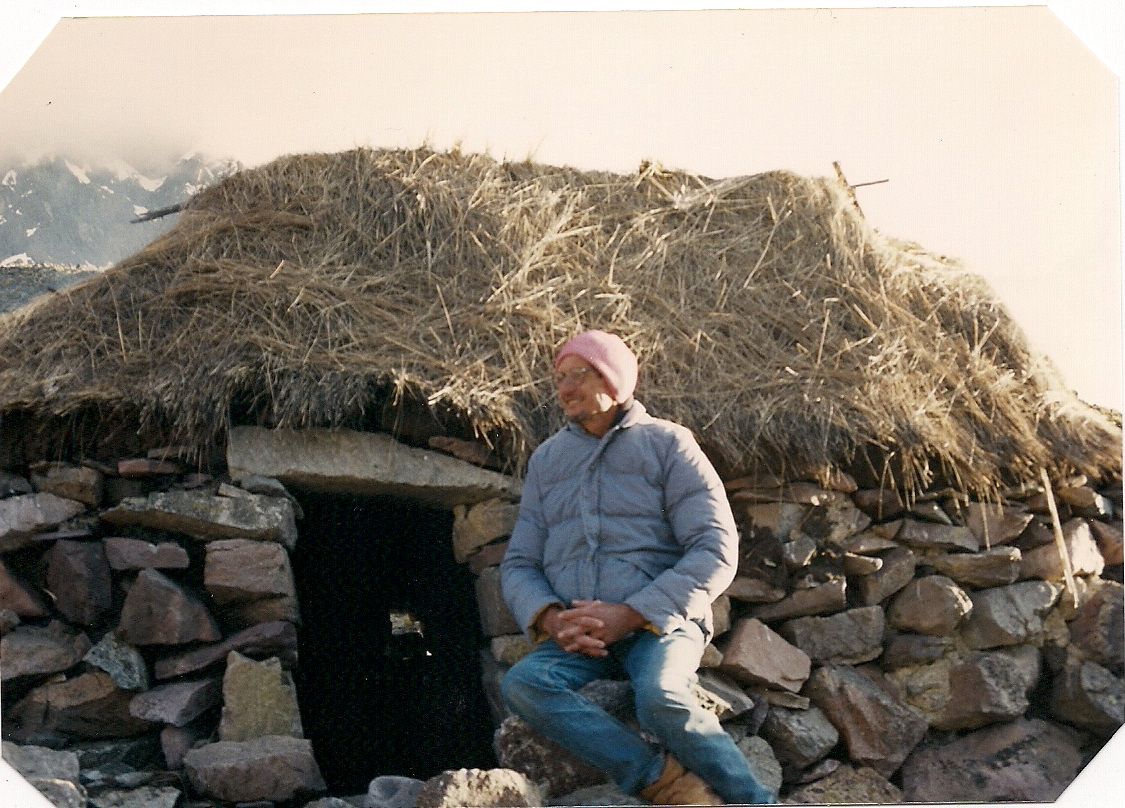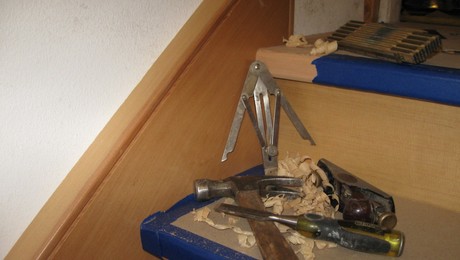
The tree
The other day as I woke from a refreshing noon-time nap, I realized that my eyes were focused on a tall, second growth Douglas fir in my neighbor’s yard. Lumber from this tree has supplied most of the material I have worked with all of my life. Given the chance, it can grow well over 300 ft. tall, more than 10 ft. in diameter, and has a long, branch free trunk.
I had a friend, Clyde, who worked here on the Oregon coast in the mills for nearly 40 years. He told me that old growth logs used to enter the mills that were 40 ft. long with maybe a 2 or 3 in. taper from end to end! I know that some Douglas fir trees can live for more than 1000 years. I know that after they clear cut these precious giants, they burn the slash and denude the hills, allowing dirt to fill the streams and wipe out the gravel beds used by salmon to spawn. Someone say amen to plentiful west coast salmon.
I know that lumber from this tree is structurally strong and a pleasure to work with. Yesterday I ran some old growth baseboard in my small shop. This beautiful, straight grain trim had 22 growth rings per inch. You can’t buy such trim today. The plantation wood we get today often has as few as 3 growth rings per inch. This I know.
But what else do I know about this tree that has supplied lumber to me for some 63 years? Well, not much! What do I know about its cones, its interior chemistry, its cellular structure, bark, sap layer, how it grows and regenerates, and on and on? Well, not much!
What I don’t know
Maybe I should have stopped there. My mind then drifted into how little I actually knew about anything—even carpentry that I have worked at for decades. The fact that I came to this is not an exercise in “eating humble pie” or feeling sorry for myself. I have always considered myself to be a life-long-learner who has a lot more to learn. Rather than this being a downer, lack of knowledge can be rather exciting. I see it as a jab in the butt that keeps me reading, observing, studying, and trying new things.
Besides that, not being a know-it-all has saved me lots of energy. I recall a good carpenter that worked with us. His name was Frank. And, like his name, he was frank about the fact that if you needed information about anything, he was the go-to guy. He would spend his lunch time and before and after work defending his know-it-all knowledge with guys that thought he was “full of crap.” Having a fixed mind and needing to prove you are right takes time and effort.
Further thoughts, then, made me realize that I had much more to learn about carpentry. I thought back to a Fine Homebuilding article about how to build a double-helix stairway. I did know what a double-helix stair was. I had visited an old church in Santa Fe, NM with an example of this type of stairway that was built in the late 1800s. But how to build such a beautiful structure was way beyond the knowledge of this old production framer.
What I do know
Yes, I can build houses. I am a framer who worked as a door hanger and trim carpenter for several years. But the trim work I was doing was not the amazing work you see someone like Gary Katz, and many others, doing. They can carve volutes and build custom cabinets with incredible joinery. I have never built most of the amazing coffered ceilings I have seen. I have spent little time building high-end houses. So the list of what I do not know about carpentry is literally endless!
So what do I know? I think that the most basic, secure knowledge that I have from my years working as a carpenter is that I know how to work with my hands, use tools, cut and shape products, and I can figure out how to build something I have never built before. And I know where to go when I need help with a construction project.
Not bad for a country boy who was born in an isolated, treeless, rural area in W. Nebr. where we lived in an old house without electricity, running water, telephone, or inside toilets. People did have Model-T cars. They also used the Sears catalog for toilet paper.
So I find no need to despair. I am grateful that I have knowledge about production framing that I can share by writing books and articles for those who want to learn this part of carpentry. And, if the need arises, I reckon I could build a double helix-stairway with information and help from many of you reading this Blog.
What do you think?
Fine Homebuilding Recommended Products
Fine Homebuilding receives a commission for items purchased through links on this site, including Amazon Associates and other affiliate advertising programs.

8067 All-Weather Flashing Tape

Affordable IR Camera

Reliable Crimp Connectors






























View Comments
The learning should never stop. When you think you know it all, watch out, because, soon you are going to get your butt handed to you. I think in order to consider yourself a professional (in any trade) you should always be a student . Always willing to listen and learn from others. And to sharpen the skills that you already have. Many times I have seen people left out because they were not willing to change, overcome or adapted to certain situations in there lives.
I have worked in homes from the late 1800's early 1900's. I am still amazed at the skill level of the carpenters back then. No power tools, all hand made. With tight miters, tight seams you can't even see. Meanwhile carpenters today are using a thousand dollar miter saw with air nailers and still cannot make a simple 90 degree miter. Makes you wonder!!
Dear Larry, I've been following Your's and Mr. Katz writings since the first time I picked up a copy of FHB more than 20 years ago. Like just about every other carpenter, I started as a framer. I got a promotion the first day from grunt, to run the saw table because I "could cut on the right side of the line". Within a few years I was trimming, hanging cabinets,and building stairs. It wasn't long before I realized there were very few who were willing or able to teach me more. That's when I discovered FHB. I waited eagerly by the mailbox for the next issue. From You I learned how to properly frame a hip roof, the economy of movements, and how to do more with less tools. I think Your humility is what makes you such a good teacher. Your also the one that taught me not to be afraid something I've never done before, to just do it. Thank You for all you do, I'm quite sure there are more out there like me. I plan to keep learning from You until You decide one day to set Your pen down. Sincerely, Andrew Brasile
Like Larry, I started very low on the totem pole I was fairly big as a kid so I got to pack lumber and clean up but I just wanted to know more and do more and to earn the right to wear those lumber yard cloth aprons and the leather hammer loop holder with that pencil in my ear! I was taken in by a smart and crafty carpenter I think only because my family was grain farmers in the midwest and had lots of pheasants to hunt but besides that he saw that I had always a interest in carpentry and my biggest motivation was to show him that I did know more than what was in a thimble as that was his most posted comment to me when I had mistakingly made a suggestion to try a different approach to something he had already had made his mind up to do.
I have always kept to myself and have never bragged or commented on others methods. I seem to let the braggers brag on all of the who's who's homes they have worked on or all of the money they make and the fancy trucks they drive.
I know that I had always been taught to do the best possible work even in the worst of times and conditions and to treat each and every project as if it was my own and by these standards I have been proud to call myself a carpenter.
A few carpenters that I had worked besides became highly sought after master handrail builders and master cabinet builders and I have always thought how and where did they pick up there abilities and keen sense for business.
I still have that first issue of Fine Home Building and seem to have around fifty of those magazines still lying around. I enjoy Larry's articles too he's the real McCoy I must say that I have never been a production guy but always admired there ability to be fast and good!
larry,
its good to see you are still at it; still thinking with an open mind and a humble spirit. have always respected you and have learned plenty from you over the years. thanks, jim ambrose
Larry, I learn so much reading your books, watching your videos. Thank you so much to share your knowledge and skills as well as your perspective.
I work masonay restoration I would like to here more about repoint stone and brick. Also I would like to see some diffent technigues in repointing or restoraion work
thanks larry i have leant so much from the way you work you make things so easy thanks a million cheers , uk joiner
The key to lifelong learning is, as Larry so rightly notes, humility. I would also include courage to the mix. Building a double-helix stairs for the first time, on your own, begins with the awareness that you have little idea what you're doing (i.e., humility). Having the courage to tackle the project with that awareness is the next step. The two in tandem, along with keeping a sharp-edged ability to learn, is the recipe for possible success. I say 'possible' because risk is always involved in such an undertaking; without it learning isn't possible.
Mortar Works,
At one time I was fairly good at laying concrete blocks, but know little about restoring brick walls, pointing, and all that goes with this trade. Not much of this is done here on on the west coast---just stucco and wood siding. You might want to put your question out on Fine Homebuilding's Breaktime. Have you tried that? That is one of the places I go to when I need help. Thanks for your questions. Larry Haun
Larry you are more than an inspiration in life, I just hope to live long and in good state of mind to keep learning, and building "things", the best lesson I learned from you is never to give up until things are well done, and not to take advantage of the good heart in people.
Larry:
I curious about where your home is, or was. in western Nebraska. My grandpa had a block plant in Gordon so I couldn't learn carpentry from him. My dad did concrete work, so no help there. I am able to work Habitat some with a master framer, so although I am 78 I am still learning. I enjoy your writing. I plan to keep on making sawdust and bending nails, though I may get a lighter hammer.
davey lee, I was raised in Harrison, NE. It is in the NW part of the state near WY & SD. RThe pop. now around 200, elevation near 5000 ft, 500 miles from Omaha, and less than 100 to Gordon. The elevation in Omaha is around 8oo ft. if I recall correctly. As we neither had an auto or much $$$, most everywhere we went was a looong trip. You do realize that there can be lots of carpentry in concrete work. I have a friend in LA who often does intricate carpentry work building forms. I left that part of the world a day after graduation from high school---1949---before I froze to death.
poetic. A pleasure reading your ramblings.
Thank you for sharing alot of knowledge about your experience of getting know about carpentry